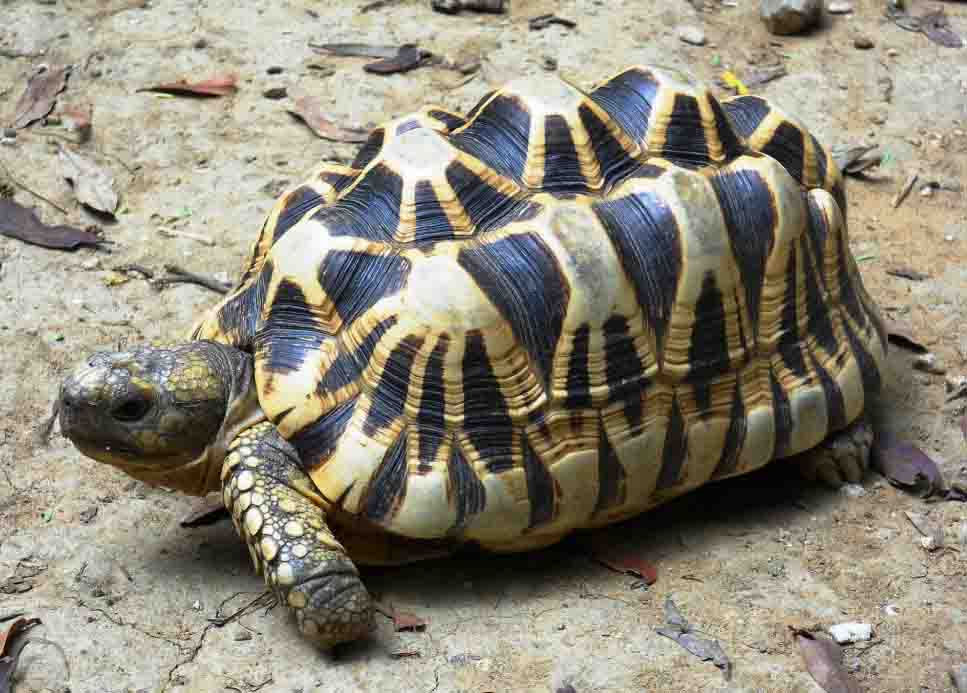Geochelone platynota, 057
Geochelone platynota (Blyth 1863) –
Burmese Star Tortoise, Kye Leik
Steven G. Platt1, Thanda Swe2, Win Ko Ko1, Kalyar Platt3,
Khin Myo Myo1, Thomas R. Rainwater4, and David Emmett5
1Wildlife Conservation Society, Myanmar Program,
Aye Yeik Mon 1st Street, Yadanamon Hosuing Ave., Yangon, Myanmar
[[email protected], [email protected]];
2Zoology Department, Yadanabon University, Mandalay, Myanmar;
3Turtle Survival Alliance, Aye Yeik Mon 1st Street, Yadanamon Hosuing Ave.,
Yangon, Myanmar [[email protected]];
4Department of Obstetrics and Gynecology, Medical University of South Carolina,
Hollings Marine Laboratory, Charleston, South Carolina, 29412, USA [[email protected]];
5Conservation International, Indo-Burma Program, #10 Street 420,
Phnom Penh, Cambodia [[email protected]]
Summary. – The Burmese Star Tortoise, Geochelone platynota (Family Testudinidae) is a medium-sized tortoise (carapace length to ca. 30 cm) endemic to the dry zone of central Myanmar. Little is known concerning the ecology of G. platynota in the wild. The species occurs in xerophytic habitats typical of the dry zone, as well as grazed pastures, hedgerows, and agricultural fields. Its diet consists largely of grass and other vegetation, but fruit, mushrooms, snails, and insect remains have been recovered in feces. Mating occurs from June to September, followed by egg-laying from October through February. The mean size of 27 clutches was 4.4 eggs, and a positive relationship was noted between female size and clutch size. Based on a limited sample, the home range of males is somewhat larger than that of females. During cool and dry periods, activity declined and tortoises sheltered in bamboo thickets, undercut banks, and rock crevices. Geochelone platynota occurs both macro- and microsympatrically with Indotestudo elongata in the dry zone, but the ecological relationship between the two species remains poorly understood. The few available data suggest that G. platynota is ecologically extinct in the wild, as a result of historic long-term subsistence harvesting and more recent over-collecting to supply illegal international food and pet markets. The last known wild populations in Shwe Settaw and Minzontaung Wildlife Sanctuaries, and Myaleik Taung are now apparently reduced to non-viable levels. Future conservation efforts hinge on developing and implementing successful captive breeding and reintroduction programs in Myanmar. Currently, offspring are being produced at several rearing facilities in Myanmar, but persistent rampant poaching precludes the reintroduction of tortoises into protected areas.
Distribution. – Myanmar. Endemic to the dry zone of central Myanmar (Burma).
Synonomy. – Testudo platynota Blyth 1863, Peltastes platynotus, Geochelone platynota, Geochelone elegans platynota.
Subspecies. – None.
Status. – IUCN 2011 Red List: Critically Endangered (CR A1cd+2cd, C2a) (assessed 2000); CITES: Appendix II, as Testudinidae spp.; Myanmar: Protection of Wildlife, Wild Plants and Conservation of Natural Areas Law: Protected.
Citation:
Platt, S.G., Thanda Swe, Win Ko Ko, Platt, K., Khin Myo Myo, Rainwater, T.R., and Emmett, D. 2011. Geochelone platynota (Blyth 1863) – Burmese Star Tortoise, Kye Leik. In: Rhodin, A.G.J., Pritchard, P.C.H., van Dijk, P.P., Saumure, R.A., Buhlmann, K.A., Iverson, J.B., and Mittermeier, R.A. (Eds.). Conservation Biology of Freshwater Turtles and Tortoises: A Compilation Project of the IUCN/SSC Tortoise and Freshwater Turtle Specialist Group. Chelonian Research Monographs No. 5, pp. 057.1–057.9, doi:10.3854/crm.5.057.platynota.v1.2011, //iucn-tftsg.org/cbftt/.
(Adobe Acrobat 6.0 or later required)

Adult Geochelone platynota at Lawkanandar Wildlife Sanctury in Bagan.
Photo by Kalyar Platt.
Distribution:
.bmp)
Distribution of Geochelone platynota in central Myanmar. Red dots = museum and literature occurrence records of historical populations based on historical and authors’ data, now all most likely extirpated; gray dots = market specimens or possible previous occurrence records mapped by Iverson (1992); red / black dots = last three known wild populations at Shwe Settaw and Minzontaung Wildlife Sanctuaries and Myaleik Taung, now also largely extirpated; green shading = projected original native distribution based on GIS-defined hydrologic unit compartments (HUCs) constructed around verified localities and then adding HUCs that connect known point localities in the same watershed or physiographic region, and similar habitats and elevations as verified HUCs (Buhlmann et al. 2009), and adjusted based on authors’ data.








